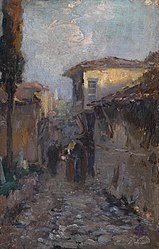Leo von Littrow
Leo von Littrow (born March 17, 1856 in Trieste , † May 11, 1925 in Abbazia , today Croatia ) was an Austrian impressionist painter.
life and work
Leo von Littrow was born as Leontine Camilla von Littrow in Trieste and was always called Leo from an early age. As a member of an old Austrian family, she had known ancestors. Her father Heinrich von Littrow , a frigate captain in the Austrian Navy, cartographer, poet and playwright later worked as head of the Trade and Nautical Academy in Trieste and as the Royal Hungarian Maritime Inspector in Fiume ( Rijeka ). Her mother, Caroline Fanny Barry, like Leo's uncle Alfred Barry and Richard Barry, came from a wealthy banking and merchant family in Genoa and Trieste. Leo's grandfather was the imperial court astronomer Johann Joseph von Littrow , who was hereditary in 1835. One of her uncles was the astronomer Karl Ludwig von Littrow , successor to his father Joseph as head of the Vienna University Observatory and Rector of the University of Vienna. He was married to the women's rights activist Auguste von Littrow , co-founder of the Vienna Women's Employment Association, the Vienna Women's Home Association and benefactress of the city, which ran a salon. Friends and friends like Franz Grillparzer , Josef Danhauser , Marie von Ebner-Eschenbach , Ottilie von Goethe , Carl von Zumbusch frequented here. The Viennese painter Hans Canon , another friend of the Littrow circle, discovered Leo von Littrow's talent as a painter during her childhood and youth stays.
Leo von Littrow grew up in Trieste and Fiume (Rijeka), and lived around 1887 in Abbazia, a marine health resort of the Austro-Hungarian monarchy. She had come here with her father, who came to this place for professional reasons. After occasional Viennese painting lessons with Hans Canon, she received her artistic training from around 1875 under the influence of French Impressionism by the equally aristocratic Parisian painter Jean d'Alheim , a student of the romantic Alexandre Calamé. After initial successes at exhibitions in Vienna, Bremen, Munich and London, Leo von Littrow was considered a successful painter of the sea and the Italian and Dalmatian coastal landscape around 1885. Later, their pergola and garden views became particularly popular. After a first joint trip to Ragusa in 1887 with Olga Wisinger-Florian , a friendship that lasted for decades developed, which was important for the art style of both artists. Leo von Littrow developed an individualistic, light-flooded and pure color style of impressionism .
Even before the turn of the century, Littrow was considered an impressionist of the south. She sold pictures to crowned heads and collectors. Ferdinand I, Prince of Bulgaria, Archduke Karl Stephan of Austria and Crown Princess Stephanie of Austria, with whom she corresponded and was friends throughout her life, frequented her studio in Abbazia. Leo and Heinrich von Littrow's closest friends and collectors of their pictures included the industrialist and co-inventor of the torpedo Robert Whitehead and his daughter and son-in-law Alice Countess von Hoyos and Georg von Hoyos.
Leo von Littrow died in her home town of Abbazia in 1925.
meaning
The painter always signed her works with “Leo von Littrow”, “Leo Littrow” or the monogram “LL”. After successful exhibitions in Vienna (1880), Bremen (1880) London (1886), Budapest (1884), Munich (1893) or Chicago (1893, Colombian World Exhibition) and above all through large solo exhibitions in London (1899, 1904, 1906) and Vienna (1914) Leo von Littrow was the only woman to receive an honorable commission from the newly built museums of the Viennese court as early as the mid-1880s: the interior painting for the mezzanine residences of the Natural History Museum shows her painting Coast of Ragusa. Littrow's works are now in the Wien Museum, the Gemäldegalerie of the Academy of Fine Arts Vienna and the Museo Revoltella di Trieste.
gallery
literature
- Bernhard Barta, Ervin Dubrovic a. a. (Ed.): Littrow. Impressionist of the south. Provincial Library Publishing House. Kohlhammer and Mahringer, Vienna 2017, ISBN 978-3-99028-717-0 .
- Littrow, Leo von . In: Hans Vollmer (Hrsg.): General lexicon of fine artists from antiquity to the present . Founded by Ulrich Thieme and Felix Becker . tape 23 : Leitenstorfer – Mander . EA Seemann, Leipzig 1929, p. 292 .
- Leo (Leontine) from Littrow. In: Marianne Baumgartner: The Association of Writers and Artists in Vienna. (1885-1938). Böhlau, Vienna / Cologne / Weimar 2015, ISBN 978-3-205-79702-9 , p. 368.
- Matteo Gardonio: La vera identità di Leo von Littrow. In: AFAT. Rivista di storia dell'arte. Arte in Friuli, arte a Trieste. Volume 34, 2015, pp. 176-180, ISSN 1827-269X . ( openstarts.units.it ; PDF).
Web links
Individual evidence
- ^ Marianne Baumgartner: Leo (Leontine) von Littrow . In: The Association of Women and Women Writers in Vienna: (1885–1938) . Böhlau Verlag, Vienna 2015, ISBN 978-3-205-79702-9 , pp. 368 ( books.google.de - And the entry on Auguste von Littrow, née Bischoff von Altenstern).
- ↑ Matteo Gardonio: La vera identità di Leo von Littrow. In: AFAT. Rivista di storia dell'arte. Arte in Friuli, arte a Trieste. Volume 34, 2015, p. 176 ( openstarts.units.it ; PDF).
- ↑ Here, however, 1860 is given as the year of birth and the person is referred to as male.
| personal data | |
|---|---|
| SURNAME | Littrow, Leo von |
| ALTERNATIVE NAMES | Littrow, Leontine Camilla von; Littrow, Leontina von; Littrow, Lea von |
| BRIEF DESCRIPTION | Austrian impressionist painter |
| DATE OF BIRTH | March 17, 1856 |
| PLACE OF BIRTH | Trieste |
| DATE OF DEATH | May 11, 1925 |
| Place of death | Abbazia , now Croatia |


